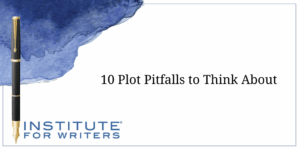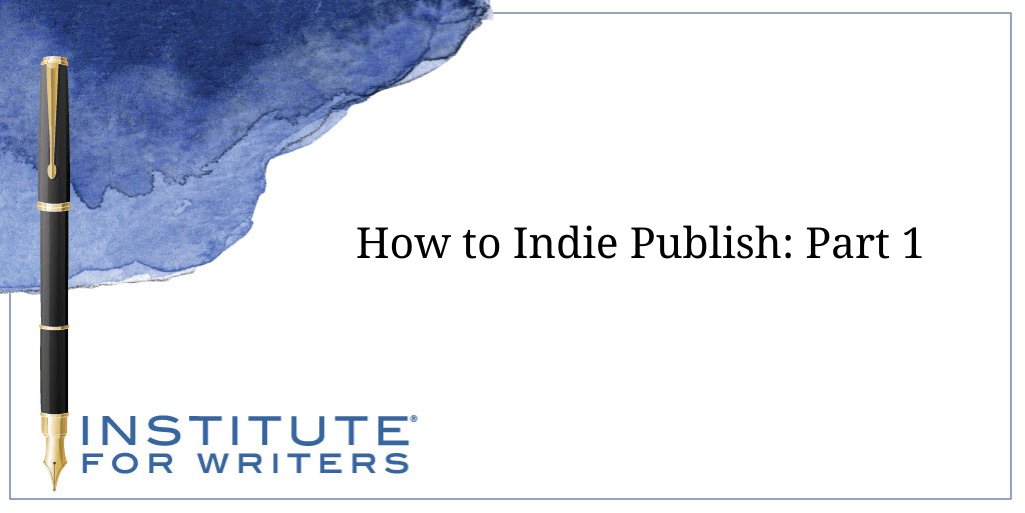
10 Plot Pitfalls to Think About
Plot can be tricky, and, as a writer, you need to be aware of what makes or breaks plot. Take a look at 10 different things to avoid in your own writing.

Becoming an indie author has its perks, like setting your schedule and controlling your project. But if one makes a few missteps, one’s book is unlikely to gain traction. This two-part article overviews the step-by-step process of publishing your own book.
 Many Facebook groups, “how-to” books, and courses are available to teach writers all about becoming a successful indie author. This overview is broken down into two articles, and they focus on the steps after you have a completed manuscript and before you upload it to distribution platforms like Amazon and Kobo. These steps include high-level insights as well as pitfalls to watch out for. Let’s go!
Many Facebook groups, “how-to” books, and courses are available to teach writers all about becoming a successful indie author. This overview is broken down into two articles, and they focus on the steps after you have a completed manuscript and before you upload it to distribution platforms like Amazon and Kobo. These steps include high-level insights as well as pitfalls to watch out for. Let’s go!
You’ve probably heard the adage to “read, read, read” when preparing to write a book. I’ve given this advice many times. But now I’m making an amendment and adding the modifier “strategic” to the critical reading homework.
Honestly, the most important thing in writing a novel is delivering a compelling story. But what qualifies as “compelling” is up to the reader and their taste. However, you’ll significantly increase your chances of finding out what your audience likes by doing your research!
This strategic reading, also known as “genre research,” might be considered the most critical step in writing a book that will sell. (But, hey, if you don’t care about selling your book, skip this step).
What is strategic reading? As an indie author, you want to read specific types of books so you can find the right audience for your book. You’ll do this by following these five steps:
1. Know your genre (aka thriller, romance, fantasy, etc): you want to identify books specifically within your genre. As you’re reading, you’ll want to start making notes about the differences between the subgenres and figure out exactly where your book fits. Once you identify your project’s subgenre, move on to the next step.
2. Know your subgenre (aka political thriller vs. psychological thriller; contemporary romance vs. historical romance; etc.): read and identify which category your book fits into, specifically. Make notes about what each subgenre has in common. What are the themes? Are they using specific terms and linguistics? Are they generally a certain length? Knowing your subgenre will help you understand the reader’s expectations. Trust me, this is important!
 Note: Readers definitely know the difference in the vibes between genres and talk about it on social media! Here’s another funny post on Instagram that showcases the different tones within one genre, depending on the specific subgenre. The book vibes couldn’t be more different. Ha!
Note: Readers definitely know the difference in the vibes between genres and talk about it on social media! Here’s another funny post on Instagram that showcases the different tones within one genre, depending on the specific subgenre. The book vibes couldn’t be more different. Ha!
3. Research the books in your subgenre that consistently sell in the top 100 on Amazon. Be aware that authors and publishers will run sales that will bump books into the top 100. So, track the top books over a month and see who consistently ranks well. Alternatively, any book in your subgenre that consistently ranks in the top 20K in the Amazon store is worth studying. Once you know the top books in your subgenre, you’ll want to pick at least three of these to read and study. Sharpen your pencil and start taking notes.
4. Read independently published books. This will take some research, but Amazon includes the publisher information on the Amazon page.
Note: Many indie publishers create small print publishing companies; all it takes is a quick Google search to determine if they’re indie or with a publishing house. Make sure 80% of the books you’re studying are indie. Indie readers look for different things than trad (traditionally published) readers. If an author wants to indie pub, one must know indie reader tastes. Trust me, it’s not the same reader experience!
5. Know the popular tropes, archetypes, and events: You’ll start seeing repeating themes in all the books you’re reading in step 3. Perhaps second-chance romance shows up in 50% of the books. Maybe in your subgenre, there’s a sword fight in the first act of 80% of the books. Perhaps your subgenre generally has a rotating POV, and they’re often in 3rd person. This research, again, helps you understand the all-important “reader expectations.”
Bonus! Pay attention when social media influencers talk about what story elements they like or here. Watch for repeating themes in online media posts. You can also figure out what tropes readers do not like (and complain about), like in this funny social media post here.
 Once you know the reader’s expectations, look at your story. How much did you include? Are you giving the readers of your subgenre what they want? If the tone, scenes, character archetypes, and tropes are all off the mark, it’s better to know now rather than when you get terrible reviews. Or worse, there are no reviews because no one is finishing your book.
Once you know the reader’s expectations, look at your story. How much did you include? Are you giving the readers of your subgenre what they want? If the tone, scenes, character archetypes, and tropes are all off the mark, it’s better to know now rather than when you get terrible reviews. Or worse, there are no reviews because no one is finishing your book.
However, if your book is too “on the nose,” readers will complain that the writing is too contrived and dull.
So, what’s a writer to do? Writers must absolutely know their subgenre and the reader’s expectations inside and out. But then, your job as the author is to subvert and twist the story so it feels fresh and new. It can be like following a recipe but then changing a few ingredients and turning the usual cake into brownies with ribbons of caramel. If readers have been getting a constant stream of cake, they’ll be delighted to get a similar dessert … but different!
If you’ve already written a draft of your book or you’re working on it, the sooner you know the reader’s expectations, the sooner you can adjust your story. Using the research from above, start making adjustments to your story.
Find out what a proper revision means in this IFW article. And here’s another IFW article with an overview of how to accomplish a revision. There are many articles on the IFW website on other specific editing tools like plotting, outlining, and pacing.
So review your notes, roll up your sleeves, and get to work.
Editing is where the story is sculpted into a masterpiece.
As you re-write your novel, now is a great time to read books outside your genre. Give your brain some different types of “fuel.” Reading widely will help you find new techniques, emotional notes, or ideas from various genres. If anything strikes you in these stories, analyze it. These new things you learn could become a part of that “fresh” take and will help your story shine.
 Step 4: Finding your alpha reader(s)
Step 4: Finding your alpha reader(s)Alpha readers are the “first readers” of your work. They are often other writers or highly skilled readers. Alpha feedback tends to be big picture, and they can give heavy advice on changing “the bones” of a story, including characters, plot, emotional arcs, etc.
This IFW article goes into a lot more detail.
If your story has sensitive topics or you’re writing outside your life experience, you’ll need to do a lot of research and may also want to hire a sensitivity reader. Yes, be prepared to pay for someone’s time for this service. If the story is problematic, then seriously consider making the changes. A sensitivity reader is someone within the community you’re writing about in your book. They will flag anything potentially offensive. Their feedback is important to consider.
Fantasy author Mary Mecham wrote a book with a deaf protagonist, Hunting Sirens. By the end of her editorial process, she had utilized seven sensitivity readers, ranging from Hard of Hearing to profoundly Deaf. She also had two CODAs (Child of a Deaf Adult) readers. She strove to ensure she was paying attention to the community she hoped to include!
If you skip this step but later a beta reader points out a problematic element in your story, you may return to this step and employ a sensitivity reader. Though I’ve listed this as “step 5,” it can be done at any point. The sooner you do this, though, the less likely it is that you’ll need to re-do the foundational elements of the story.
Many articles are available online on how to find and hire a sensitivity reader; this is a good point in the writing process to incorporate this step.
You’re halfway through the introduction to becoming an indie author. At this point, you’ve gotten a good base for your story in preparation for publishing. The next article will explore finding an editor, beta, ARC readers, and more! Read part 2 here!
Kristin J. Dawson is a non-recovering chocolate and romantic English movie addict who loves to read science fiction and fantasy. You can find her most often indulging her favorite things at 2 am — night owls unite! Kristin writes high fantasy with political intrigue, a bit of romance, and of course, magic. She’s was a 2019 UTOPiAcon Debut Book Award Nominee and Swooney Award Nominee. When she’s not writing, taking her kids on mountain adventures, or cleaning out the chicken coop, she’s probably trying to talk her author friends into more shenanigans.
Chat with Kristin on Instagram (@KristinImagines), on Facebook (@KristinJLiterary), or her website at kristinjdawson.com.

Plot can be tricky, and, as a writer, you need to be aware of what makes or breaks plot. Take a look at 10 different things to avoid in your own writing.

Plot is more than just the chain of events within a story. There are so many elements to plot to consider when writing. Let’s dive into those elements.

Visiting new places is key to exploring new ideas and finding inspiration. Let’s see the places you can go this summer to spark your next story.
1000 N. West Street #1200, Wilmington, DE 19801
© 2024 Direct Learning Systems, Inc. All rights reserved.

1000 N. West Street #1200, Wilmington, DE 19801
© 2025 Direct Learning Systems, Inc. All rights reserved.

1000 N. West Street #1200, Wilmington, DE 19801
©2025 Direct Learning Systems, Inc. All rights reserved. Privacy Policy.
3 Comments